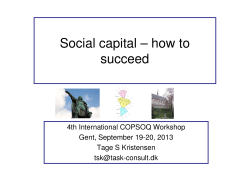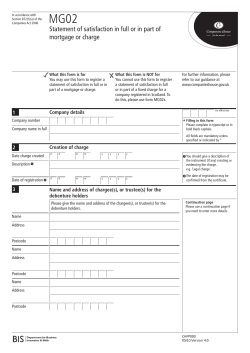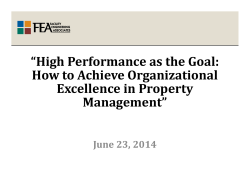
Citizen-Centred Service Measurement in Canada: From Research to Results Brian Marson
Citizen-Centred Service Measurement in Canada: From Research to Results Brian Marson Senior Advisor Treasury Board of Canada OECD Senior Budget Officials Madrid, October 2007 What is Citizen-Centred Service? “Citizen-Centred Service incorporates citizens’ concerns at every stage of the service design and delivery process; that is, citizens’ needs become the organizing principle around which the public interest is determined and service delivery is planned.” -Deputy Ministers’ Task Force on Service Delivery Models (1996) 2 Presentation Outline 1. Canada’s Improving Service Performance: How is government service delivery performing in the eyes of Canadians? 2. Listening to Citizens : How Canada systematically identifies citizens’ and clients’ service expectations, satisfaction levels, and improvement priorities using national surveys at the national level and the Common Measurements Tool at the program level; Applying the CMT to measure and improve performance- Royal Canadian Mounted Police example; Benchmarking performance; the ICCS benchmarking Service; 3. What the Research Tells Us: Drivers of service satisfaction; performance on each driver; what service standards clients expect; 4. Applying the Research to Improve Client Satisfaction Scores: Governance; Key Service Improvement Strategies: Service Canada, Service Improvement Initiative; GOL, and Service Transformation; How to improve client-satisfaction results through a “laser-guided service improvement” system: 3 5. The Public Sector Service Value Chain: Canada’s research into the connections between engaged staff, internal and external service satisfaction, and public trust confidence in the public service. 1. Canada’s Recent Performance 4 Canadians Say that Public Sector Service is Steadily Improving Service reputation scores Citizens First 1 to 4 "What was the quality of the service for your… government in general?" Service Quality Scale (0-100) 100 80 60 53 57 59 63 50 47 51 52 47 51 59 56 40 20 5 0 Municipal Provincial/Territorial CF1 CF2 CF3 Federal CF4 Service Quality Scale (0-100) The Government of Canada has Achieved a 12% Improvement in Citizen Satisfaction Compared to Citizens First 1998 (18 Core Services 1998-2005) 80 70 60 61 64 67 60 50 40 30 6 20 1998 2000 2002 2005 Key Federal Services are Achieving Higher Citizen Ratings* (Trend: 1998 to 2005) 7 * General service rating. CMT scores for a recent experience are higher. Outperforming the Private Sector “Many public sector services outperform mainstream private sector services in the eyes of Canadians” (Citizens First-4 Survey, 2006) How do public and private services compare? Citizens First 1 and 4 Mean Service Quality Score (0-100) Services Private Government CF1 CF4 CF1 CF4 - - 77 84 Supermarkets 74 71 - - Canada Post - - 57 70 68 74 - - - - 58 68 Taxis 57 64 - Average rating across services shown 66 70 64 Visited a public library Private mail carriers and courier companies Used municipal public transit (bus, streetcar, subway) -8 74 2. Systematically Listening to Citizens, Businesses and Clients Identifying Expectations, Satisfaction Levels, Drivers, Issues, and Improvement Priorities 9 Listening to Canadians • Understanding the Big Picture (Citizen Level) – – – – Citizens First national surveys Taking Care of Business national surveys Canada Internet Panel (10,000 people) National focus groups (e.g. telephony) • Departmental/Program Level (Client) – The Common Measurements Tool (CMT) • Developed by public managers for public managers • Housed at the Institute for Citizen Centred Service www.iccs-isac.org • The CMT is based on the known “drivers” of client satisfaction10 • The CMT permits programs to benchmark their results with others Listening to Citizens: National Surveys (sponsored by all levels of government) 11 Listening to Canadians: the Government of Canada Internet Panel • Over 10,000 Canadians are recruited to the Canada Internet Panel each year; • Several general surveys on service satisfaction and service issues are conducted with the panel throughout the year; • Individual departments use the Internet Panel to test service proposals, such as new websites, as well as policy, program design and delivery issues; • On-line focus groups are conducted around service issues • Canada has used Internet-based citizen panels for almost a12 decade. Canadians Like Being Part of the Panel • “I think this was a great idea and a good forum to get some voices heard.” • “It is a good way to test to make sure things are going the way you think they are going.” • “How else are you going to get information from all 13 of us Joe and Joan citizens out there.” Recognition for the Internet Panel: “Canada also leads the world in its systematic engagement with its citizens’ views. The Internet Research Panel recruits 10,000 people from across the country each year to participate in online polls, discussions and focus groups, covering every topic from online services to foreign policy.” Sarah Arnott – Computing.co.uk (April 5, 2007 “This innovative On-Line Citizens Panel…” “Canada has developed standing panels of citizens 14 that the government can tap at any point to get direct and detailed feedback…” Accenture 2003 & 2007 Listening to CanadiansResearch on Specific Service Issues • Each year the Canadian inter-governmental service community sponsors citizen-business survey research on major issues; • A recent example is a project to improve telephone service for Canadians- “Answering the Call”, which involved both focus groups with citizens, as well as best practice research. 15 Listening to Clients and Improving Service: The Common Measurements Tool 16 Obtain from: www.iccs-isac.org CMT overview 1999 Gold Award • A multi-channel instrument for designing client satisfaction surveys; has a “bank” of standard questions; • Based on empirical research into the “drivers” of service satisfaction 2000 Silver Award • Designed by public servants, for public servants • Enables public organizations to benchmark results with others if the “core questions” are used; 17 • Being used at all three levels of government across Canada and in a growing number of other countries What “drives” citizen satisfaction with public sector service delivery? Timeliness I was satisfied with the amount of time it took to get the service Outcome In the end, I got what I needed Extra mile Staff went the extra mile to help me get what I needed Fairness I was treated fairly Knowledge Staff were knowledgeable The five drivers account for almost 75% of the variance in satisfaction ratings 18 Performance on the The Five Drivers Determines Satisfaction Levels (CF3) These clients rated service 4 or 5 out of 5 on all five drivers 100 Overall service quality rating 80 87 74 63 60 40 55 37 22 20 0 Copyright ICCS-ISAC 2003 5 4 3 2 1 0 Number of drivers scoring “Good” (where “good” is 4 or 5 out of 5) 19 The ICCS CMT Standards Board The CMT Standards Board is responsible for: • • • • • • • Setting standards with respect to the CMT (e.g., core items) Overseeing further development of the CMT (for example, the development of alternative methodologies such as new applications for specific service channels) Conducting reviews of the CMT* Recommending revisions to the tool Approving consultants using the tool Advancing development of support materials for the CMT (e.g., training products) Supporting CMT marketing activities 20 Registered Requests for the CMT CMT Registrants 2003-2007 Total number of registrants 1400 1200 1185 1000 964 800 719 600 400 418 200 154 0 2003 2004 2005 2006 2007 Years 21 www.iccs-isac.org Departmental Service Satisfaction Results (CMT) 10 20 30 40 50 60 70 80 90 100 OAS/Canada Pension Plan Clients Employment Insurance Clients Royal Canadian Mounted Police Veterans Affairs Canada 2001 2005 2003 Canada Business Service Centres Service New Brunswick & Service BC 22 Citizen-centred Service Measurement- a Key Component of the Treasury Board of Canada’s Management Accountability Framework (MAF) 23 Example: Using the Common Measurements Tool in the Annual RCMP Citizen Surveys Regarding your contact(s) with the RCMP during 2004, please indicate whether you strongly disagree, disagree, neither agree nor disagree, agree or strongly agree with each of the following statements about the RCMP’s performance, starting with... (if a statement does not apply to a respondent, select "not applicable".) RCMP personnel treated me fairly RCMP personnel demonstrated professionalism RCMP personnel were courteous and respectful RCMP personnel were knowledgeable and competent RCMP personnel delivered the service in a timely fashion RCMP personnel went the "extra mile" to provide good service RCMP personnel gave me all the information that I needed for the situation (IF Q6 = Yes) It was easy to get in touch with the RCMP How satisfied were you with the service you received during your contact(s) with the RCMP? Were you... •Very satisfied •Somewhat satisfied Neither satisfied nor dissatisfied Somewhat dissatisfied Very dissatisfied Don't know / no answer 24 What Canadians, who have had contact with the RCMP, are saying (CMT Survey) 100 75 50 25 25 0 Timely service 2003 Extra mile 2004 2005 Outcome Satisfaction 2006 2007 26 27 The ICCS Common Measurements Tool Benchmarking Service • The Government of Canada (Treasury Board) and the Provincial governments have collaborated to develop a CMT data repository and benchmarking centre at the ICCS (www.iccs-isac.org); the benchmarking service is confidential and is managed by a Treasury Board office seconded to the ICCS (vicki,morrison@ontario.ca ); • Over 1200 public managers have registered to use the CMT survey; • Results from over 150 surveys are held in the data base; • Confidential benchmarking reports, comparing a department’s results with similar public organizations are issued to organizations who submit their data to the ICCS data repository; 28 • The CMT has now been licensed to other counties (e.g. New Zealand; 2 Australian States; Bermuda, Qatar etc) offering the opportunity for international benchmarking of service satisfaction results around the world. • OECD countries may wish to consider adopting the CMT for this purpose. CMT Benchmarking Database There is a central database for CMT data, which allows organizations to anonymously compare results against peers. The ICCS produces CMT benchmarking reports – analysis includes: Service Gaps: The difference between what a client expects to get and how they perceive the actual service experience. Service Standards: Understanding what a client believes to be an acceptable level of service. Satisfaction/Importance Matrix: Assessing satisfaction scores relative to importance scores. Drivers of Satisfaction: What drives satisfaction in specific service areas? 29 3. What the Citizen-centred Research Tells Us 30 The Citizens First Service Model Citizens First Service Model Citizen’s Needs & Expectations Finding/Accessing the Service or Group of Related Services FINDING THE SERVICE ACCESSING THE SERVICE -e.g. knowing the - e.g. parking, or service location or phone # getting through on the phone or Internet. Service Delivery/ Quality SERVICE DELIVERY QUALITY: One’s experience with the service provider - why clients are or are not satisfied with the service they receive. Improving Service PRIORITIES FOR 31 IMPOVEMENT - using the survey results to guide improvements HOW CITIZENS EXPERIENCE PUBLIC SERVICES: THE “OUTSIDE-IN” VIEW Citizens’ Needs & Expectations Finding/Accessing the Service or Group of Related Services FINDING THE SERVICE •Citizens (97%) expect as good or better service from the public sector than from the private sector. •Sixteen percent of the time citizens need more than one government service, generally when dealing with life events like births, deaths, travel, unemployment and inter-provincial migration. ACCESSING THE SERVICE •25% of Canadians did not know where to find the service they needed. •Confusing Blue Pages •Services not well advertised •Two thirds of Canadians had one or more problems accessing the service(s) once they new where to find it: •Busy telephones •Voice Mail •Interactive voice response •“Not my department” •Citizens were required to manage the “white space” between related services (service clusters) Service Delivery/Quality SERVICE DELIVERY:Citizens’ experience with the service provider. •Public services were rated an average of 64 out of 100-- the same as the private 68 sector. ••Five factors drive service satisfaction: timeliness; competence, courtesy/extra mile; fairness and outcome. •When all five factors are performed well public services score 89 out of 100; when one driver fails the score drops to 76 out of 100; when two fail the score drops to 63- the current average. When one driver 32 fails, 60% of the time it is timeliness. •Citizens priorities for service improvement include: •one stop service • Improve telephone service •improve improve timeliness © ICCS-ISAC What Drives Citizen Satisfaction with Access? 33 What “drives” satisfaction for each channel? TELEPHONE INTERNET IN-PERSON 1. Outcome 1. Timeliness 2. Reaching a live person 2. Courtesy 3. Accurate numbers 3. Knowledge, competence 4. Not being bounced around 4. Outcome 5. Timeliness 1. Outcome: I got what wanted 2. Easy to find what I'm looking for 3. Sufficient information 34 4. Ease of site navigation Source: Citizens First 4, 2005 How are we doing on the “drivers”? 100 72 80 69 64 55 60 51 40 20 35 0 1 Outcome 2 Fairness 3 Knowledge/ competence 4 Courtesy/ extra mile 5 Timeliness Source: Citizens First 3, 2003 Citizen Satisfaction by Service Channel Despite being the most popular channel, the telephone consistently delivers some of the lowest satisfaction scores 68 Internet/email Office visit 62 Kiosk 62 Phone 56 Mail 55 54 Other 0 Very poor © Institute for Citizen - Centred Service 36 25 50 SERVICE QUALITY 75 100 Very good Service Standards: Citizens’ Expectations 50 Telephone 40 Percent of respondents 32 30 20 17 20 10 0 75 Percent of respondents 3 42 39 1998 2002 Percent of respondents 20 25 5 1 2-4 5-9 10-14 44 30 43 40 Number of minutes 37 29 24 10 10 15-29 1998 2000 2002 52 50 25 14 2 1 Email 75 35 30 5 10 sec 20 sec 30 sec 1 min 2 min 3 min 4 min 5 min In-Person 50 0 7 6 10 1 1 30-60 12 5 >60 0 4 hr 2 Same day Next business day 6 2 days 1 3 days + 2 Service Standards: Two Models 1. The Ontario Government Model – – Standards are built around Citizens First findings of Canadians’ specific expectations (e.g. 10 minute waiting time in line); Government wide standards are set and monitored for waiting times, interactive voice response systems, responding to mail etc. 2. The Alberta Government Model – Standards are set as a percentage satisfaction with waiting times, courtesy, competence, fairness etc. (e.g. 38 80% satisfaction with timeliness) 4. Using the Research to Develop Public Sector Service Strategies, and to Improve and Benchmark Client Satisfaction Results 39 Canada: Creating “communities of practice” The Public Sector CIO Council The Institute for Citizen Centred Service (pan-public sector) Public Sector Service Delivery Council (Federal-Provincial-Territorial members) 40 The Citizen Centred Service Network (CCMD) 1997 1998 2001 2007 2006 Government of Canada Service Strategies • 1. Improving Access and Single-window Service (Service Canada; 1-800 OCANADA; Canada-OntarioOttawa Common Service Counter) • 2. Improving Departmental Service (The Service Improvement Initiative) • 3. Expanding E-Service (Government OnLine) • 4. Emerging Strategy: Service Transformation – Internal Services transformation (whole of government) – Departmental services transformation (e.g. Integrated customer contact centres; process re-engineering) – Inter-governmental: common research, common tools (BizPal; 41 BTEP; CMT), common standards, common systems, integrated service delivery (e.g. Canada-Ottawa-Ontario ISD). – The Service Value Chain The Government of Canada’s Citizen-Centred Service Strategy Citizens’ Service Needs and Expectations Citizen Surveys Every Two Years Improved Access Main Services On-line Improved Service Quality Annual CMT Client Surveys 10% Client Satisfaction Improvement Target Service Service Canada & Government Improvement Initiative On-Line Gateways & Service Transformation Citizen-Centred Service Delivery 42 Applying the Research and Measurement Insights to Improve Client Satisfaction 43 The Service Improvement Initiative: Improving citizen satisfaction through a focus on measurable results http://www.tbs-sct.gc.ca/sias/index_e.asp All departments and agencies directly serving citizens adopt a systematic approach to service improvement planning integrated with their annual business planning process Service satisfaction measured at least annually using the Common Measurements Tool metrics Treasury Board set a minimum 10% service satisfaction improvement target, for 2000-2005 Targets and performance against targets measured and reported annually Accountability for results Free: Obtain the How-to Guide: www.iccs-isac.org 44 Canada’s Results-based Service Improvement Model Where Are We Now? Measure Clients’ Satisfaction Measure Clients’ Stisfaction Where Do Our Clients Want Us To Be? Measure Clients’ Expectations & Priorities Priorities How Will We Get There? Set Targets & Develop Service Set Targets & Improvement Plan Develop Service Improvement Plan How Do We Make It Happen? Implement, Monitor, Measure & Monitor, Ensure Implement, Accountability Measure & Ensure Staff Involvement 45 5. The Public Sector Service Value Chain*: the Relationship Between Employee Engagement, Service Delivery, and Trust and Confidence in Public Institutions People Service Trust Employee Engagement (Satisfaction & Commitment) Client Satisfaction Citizen trust & confidence in public institutions 46 ©Heintzman and Marson 2003 47 3. Researching the Service Value Chain: Exploring The Links in the Chain The Public Sector Service Value Chain Employee Engagement Citizen/Client Service Satisfaction Citizen Trust & Confidence In Public Institutions DRIVERS OF PERFORMANCE DRIVERS OF PERFORMANCE DRIVERS OF PERFORMANCE Researching the Drivers and the Links in the Chain ©Heintzman and Marson 2006 48 49 Service Delivery and Democratic Citizenship Each service experience is a moment of truth Strengthens or weakens confidence in public institutions and democratic citizenship Both the challenge and the glory of service delivery in the public sector 50
© Copyright 2025




















